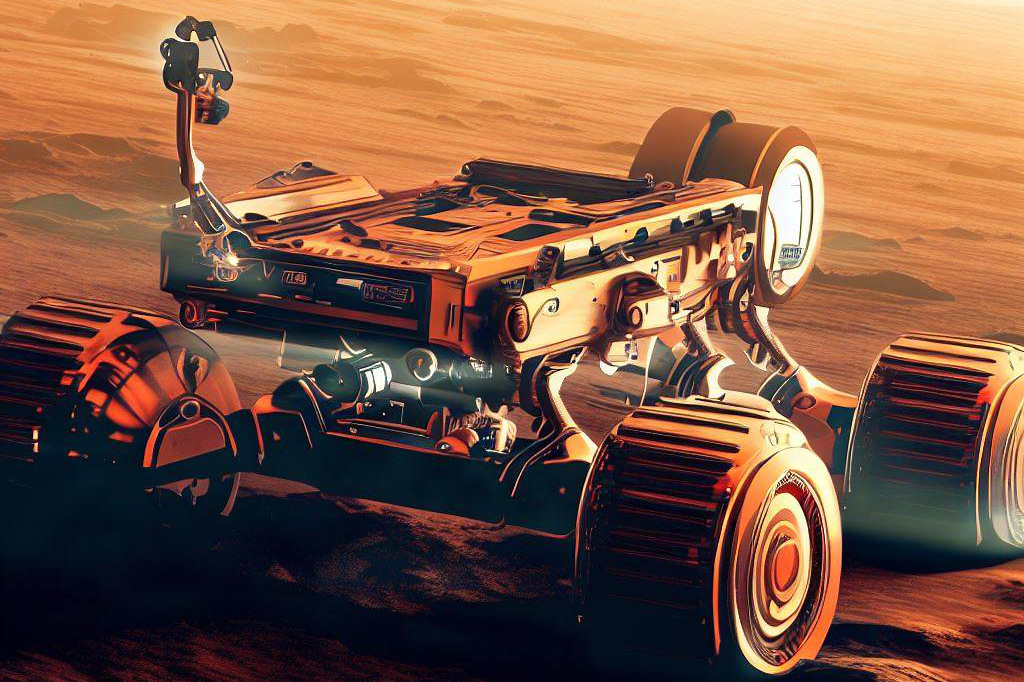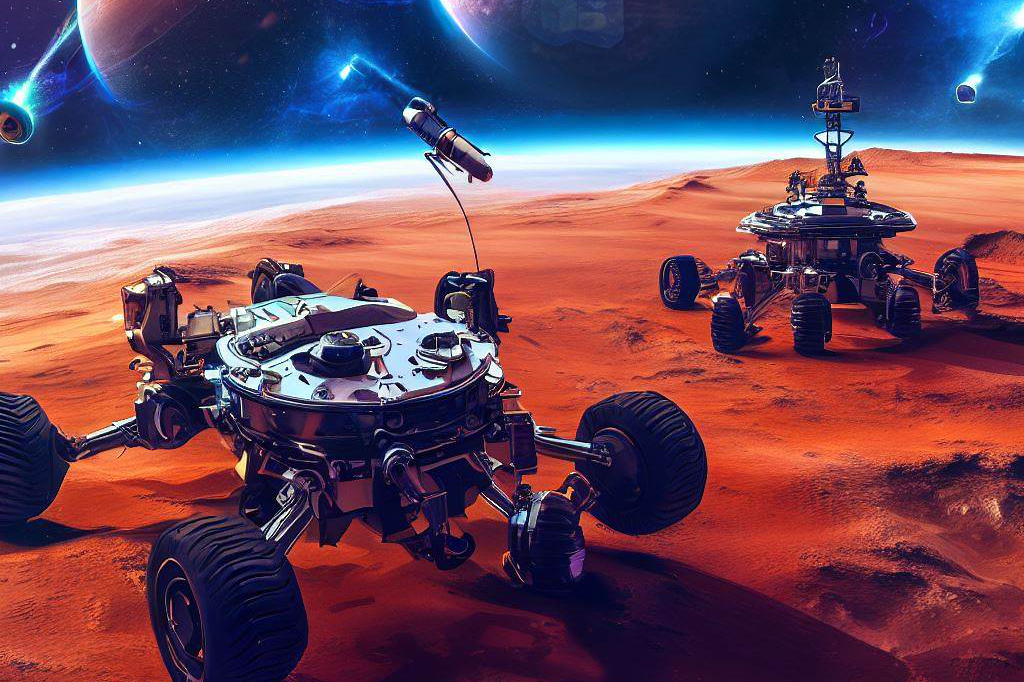In our search for extraterrestrial life, one planet has consistently captured our attention: Mars.
Mars, the fourth planet from the sun, is often referred to as the “Red Planet” due to its reddish appearance in the night sky. But beyond its striking color, Mars has long been of interest to scientists due to its potential for hosting life.
What makes Mars an appealing target for scientific exploration?
For starters, it’s relatively close to Earth, which makes it easier and more cost-effective to send missions there. Additionally, studies have shown that in the past, Mars had a much more habitable environment than it does today. Evidence suggests that liquid water once flowed on the planet’s surface and that there may be subsurface oceans of liquid water today.
The Search Continues: Current Missions
Despite numerous past missions to Mars from various space agencies around the world, we’ve yet to find definitive evidence of life on the planet. However, we’re not giving up hope just yet – in fact, there are several upcoming missions planned that could bring us closer than ever before to uncovering the truth about life on Mars.
One mission currently underway is NASA’s Perseverance Rover mission. Launched in July 2020 and expected to spend at least one Martian year (about two Earth years) exploring a crater called Jezero that was once a lake.
Its primary goal is to search for signs of ancient microbial life and collect samples of rock and soil that could potentially be returned back to Earth by future missions. In addition to Perseverance, there are other missions from various countries planned over the next few years.
This includes China’s Tianwen-1 mission, which also launched in July 2020 and is aiming to study the planet’s atmosphere, magnetic field, and potential for life.
The European Space Agency is expected to launch its ExoMars rover (renamed: Rosalind Franklin) soon (indefinitely delayed due to the Russia/Ukraine war) with the same goal of searching for signs of past or present life on Mars.
As these new missions get underway, we’re sure to learn more about the mysterious Red Planet and its potential for hosting life. Whether we find definitive evidence of extraterrestrial organisms or not, our continued exploration of Mars will undoubtedly deepen our understanding of this fascinating planet and its place in our solar system.
The Search for Life on Mars

Past Missions to Mars
Humans have been intrigued by the possibility of life on Mars for centuries.
The first mission to attempt to answer this question was NASA’s Viking program, which included two spacecraft that landed on the planet in 1976.
These missions were groundbreaking at the time, but they ultimately failed to find any conclusive evidence of life on the planet.
Since then, numerous missions have been launched with a specific focus on discovering whether there was ever life on Mars.
The Curiosity rover, launched in 2011, has found evidence that water once flowed on the Martian surface – a key ingredient for life as we know it. Other missions, like ExoMars and Insight are helping scientists understand more about the planet’s atmosphere and seismic activity.
Current Scientific Research
Recent scientific discoveries have given researchers reason to believe that Mars may have once been habitable. However, no direct evidence of past or present life has been found yet. Some scientists are currently exploring the possibility that microbial life may exist beneath the surface of the planet – where it is protected from harsh surface conditions and radiation.
NASA’s Perseverance rover aims to take this research a step further by collecting samples from Mars’ Jezero Crater and storing them for future analysis back on Earth.
Additionally, ESA’s Rosalind Franklin ExoMars rover and China’s Tianwen-1 mission will also conduct experiments aimed at finding signs of past or present microbial life.
The search for extraterrestrial life is a long-term project that requires significant resources and patience. But with every mission, we learn more about our cosmic neighbors, which brings us closer to answering one of humanity’s biggest questions: are we alone in the universe?
The Current Mars Missions

Searching for Clues on the Red Planet
NASA’s Perseverance Rover mission – the rover itself, which is about the size of a small car – will gather samples of rocks and soil from Mars that will be analyzed for signs of past microbial life.
The mission will also study the planet’s geology and climate, with the goal of paving the way for future human exploration.
Other current missions to Mars include the United Arab Emirates’ Hope Mission.
This mission will study the planet’s climate by observing its atmosphere and weather patterns.
China’s Huoxing-1 mission will include an orbiter, lander, and rover that will search for water ice on Mars.
Mars: A Global Destination
Mars has become a popular destination for space agencies around the world.
Europe’s ExoMars Rover mission was originally planned to launch this year but has been postponed until 2028 due to technical difficulties with its parachute system, and as in partnership with Russia, postponed because of the Russia/Ukraine conflict. When it does launch, it will carry a drill capable of drilling two meters into Martian soil in search of life.
In addition to these missions, there are several other proposed missions being developed by various countries, such as
- India’s Mangalyaan-2 orbiter mission
- and Japan’s Martian Moons Exploration (MMX) sample return mission
is slated for departure around 2024.
The search for life on Mars continues with these upcoming missions.
As technology advances and our understanding of this planet grows deeper, we move ever closer to answering one of humanity’s greatest questions: Are we truly alone in this vast universe? Only time will tell, but these missions provide hope and excitement for the future of space exploration.
Challenges of Living on Mars

The Red Planet’s Extreme Conditions
Living on Mars may sound like a thrilling adventure, but what many people fail to realize is that the planet’s harsh conditions are not conducive to human life.
For starters, Mars has no atmosphere to speak of, which means that there is no protection from harmful cosmic radiation or meteorite impacts.
The temperature on Mars can also be extreme, with temperatures dropping as low as -225°F (-148 Celsius) at night and peaking at just 70°F (21 Celsius) during the day. This makes it difficult to maintain a safe and stable environment for humans to live in.
The Problem with Radiation Exposure
Radiation exposure is one of the biggest challenges that astronauts must face when living on Mars.
Unlike Earth, which is protected by its magnetic field, Mars has no such protection from the sun’s harmful rays. This means that any humans living on Mars would be constantly exposed to high levels of radiation, which can lead to an increased risk of cancer and other health problems.
Potential Solutions
Despite these challenges, scientists are working hard to find solutions to make living on Mars a viable option for humans in the future. One potential solution is terraforming: transforming the planet’s environment through various methods such as introducing greenhouse gases into the atmosphere or melting ice caps in order to create liquid water and a breathable atmosphere.
Another possible solution is building habitats underground or beneath protective domes that shield inhabitants from radiation and extreme temperatures. These habitats could be equipped with advanced life support systems that recycle air and water, making them self-sustaining for long periods of time.
While there are certainly many challenges associated with living on Mars, scientists remain hopeful that they can be overcome through innovative thinking and advanced technology. With several upcoming missions planned in the coming years, we may soon learn more about the potential for human habitation on the Red Planet.
The Future of Exploration and Colonization

Exploring Possibilities for the Future
As we continue to learn more about Mars, the idea of exploring and eventually colonizing the planet becomes more realistic.
Future missions to Mars will likely focus on further exploration and gathering data necessary for potential colonization efforts. One possibility for expanding human presence on Mars is by establishing small research stations that house scientists and engineers conducting research on how to sustain life on the planet.
Another possible way to colonize Mars involves the aforementioned idea of terraforming, a process of transforming a planet’s environment to make it more habitable for humans. This would require creating an atmosphere where none currently exists, which would be a monumental task requiring many years of work.
Ethical Considerations Surrounding Colonization
While the idea of living on another planet may seem exciting, it is important to consider the ethical implications of colonizing Mars. One major concern is whether or not we have the right to alter another world’s environment for our own purposes. Furthermore, there are concerns about how colonization could affect any existing microbial life that may exist on Mars.
There are also practical concerns, such as who will be responsible for governing a colony on Mars and ensuring that everyone living there has access to basic necessities like food, water, and medical care. There are also questions about what safety measures should be put in place in case something goes wrong.
While there are many exciting possibilities when it comes to exploring and potentially colonizing Mars, we must carefully consider all the pros and cons before taking action. The future of space exploration is filled with both opportunities and challenges, but by carefully examining all aspects of this issue, we can make informed decisions that will benefit us all in the long run.
Final Thoughts

The topic of potential life on Mars has been a fascinating subject for scientists and space enthusiasts alike. Through past missions to Mars, we have learned a great deal about the planet’s geology and atmosphere, increasing our understanding of its potential for hosting life. The upcoming Mars missions are poised to take this research to the next level, with advanced technology designed to search for biosignatures and other evidence of past or present life.
With advancements in technology and potential solutions such as terraforming or utilizing existing resources on the planet like ice deposits or carbon dioxide for fuel, humans could create a thriving civilization on another planet. Overall, many questions remain about potential life on Mars and the challenges of exploring and colonizing it, these upcoming missions provide hope that we may one day find answers – and perhaps even establish a new home beyond Earth.

C M, a seasoned editor, journalist, and consultant, is deeply fascinated by the convergence of technology, space, and the future of humanity.
With a particular interest in transhumanity, futurology, and the philosophical and ethical dimensions of these domains, C M serves as the lead contributor to SpaceSpotlight and TranscendSphere.
When not penning insightful articles on these rapidly evolving fields, C M indulges in their love for podcasts and books, proudly embracing their status as a ‘Happy Nerd Extraordinaire!’



